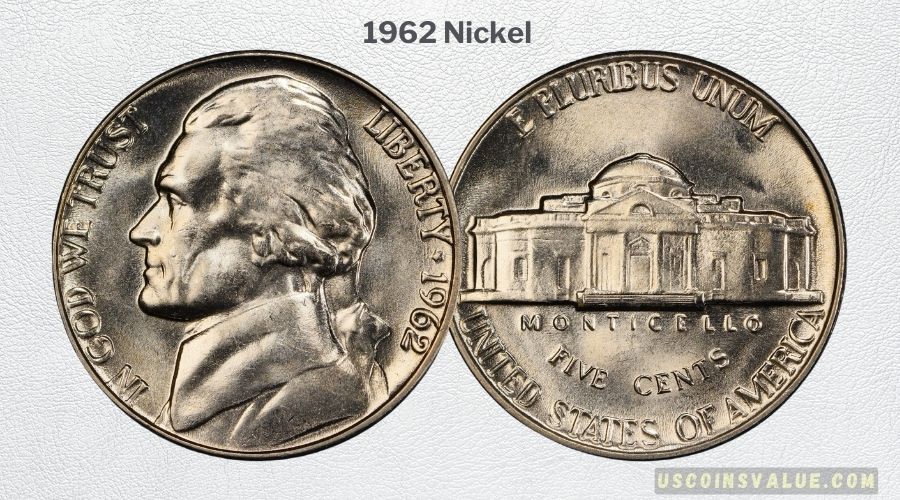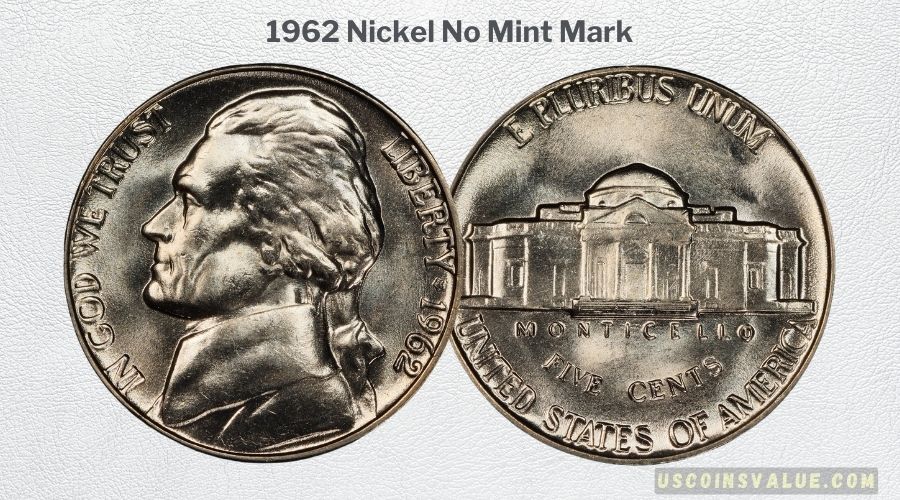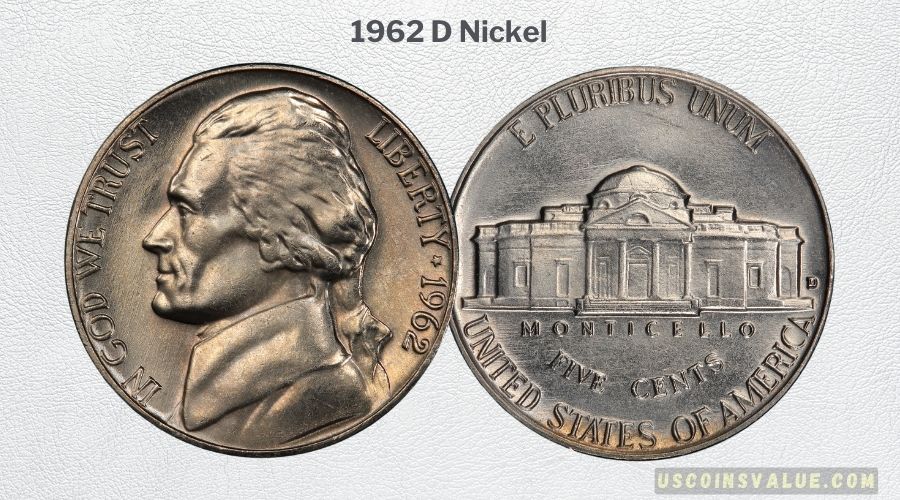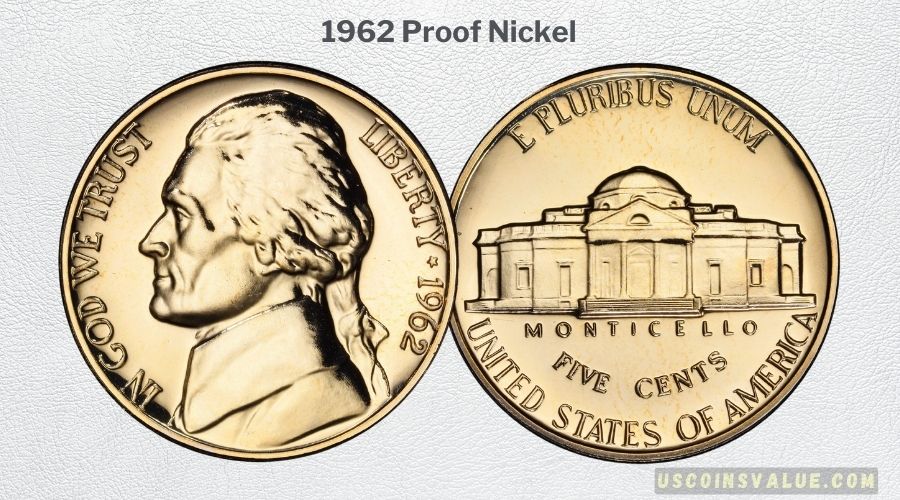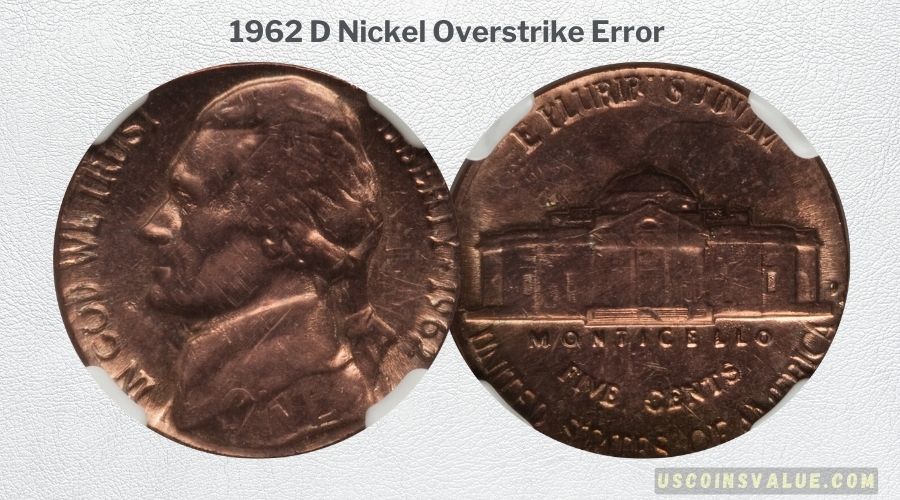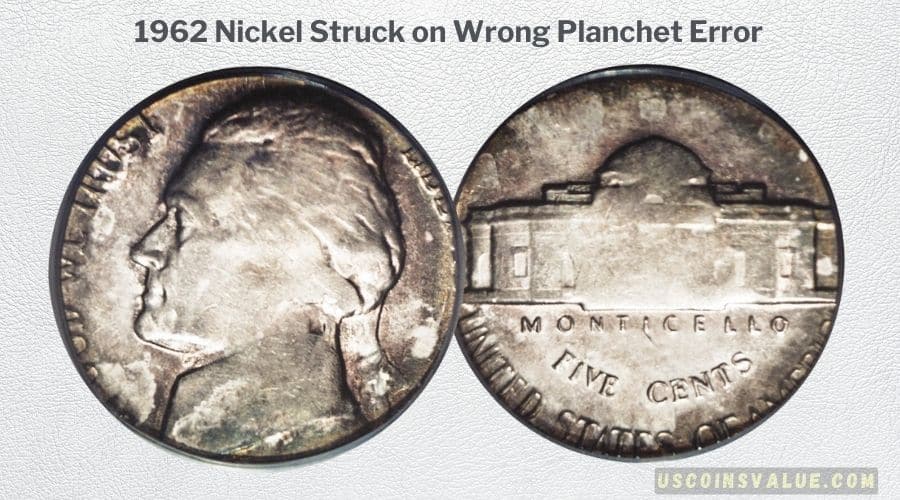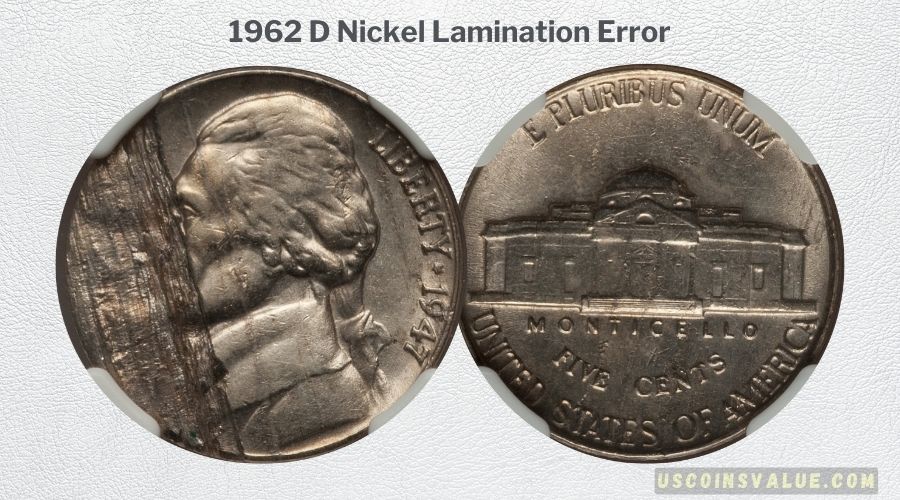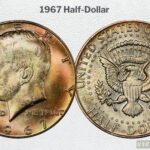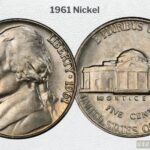So, you have a Jefferson nickel in your coin collection and wonder, how much is a 1962 nickel worth today?
Well, most circulated 1962 nickels are worth their $0.05 face value and some a few more cents, $0.10-$0.15.
But don’t throw in the towel yet. That value can go up to $500 if your 1962 nickel has a high mint state grading and further up to $1,600 if it has the Full Steps (FS) designation.
Note: Graders assign the FS designation to Jefferson nickels with a quality strike, presenting 5 or 6 fully separated and clearly defined steps of the Monticello.
And if your 1962 nickel is a Gem in pristine condition, we could be talking up to $21,150 for the highest-valued 1962 nickel as of this writeup.
Before you dream of selling your 1962 nickel for that much, there are some finer details you should know about. These include factors like grading and coin condition, the mark of the mint that struck the coin, and if the nickel has mint errors that please the eye of coin collectors.
We’ll anticipate some of those details with this 1962 nickel value chart, which is a more complete answer to your “How much is a 1962 nickel worth” question.
| 1962 Nickel Value Chart | ||||
| Mint Mark | Circulated (Good: 4 – Extra Fine: 40 grading) | About Uncirculated (AU50-58) | Uncirculated (MS60-65) | Uncirculated (MS66-67) |
| 1962 no mint mark Nickel | $0.10 | $0.10-$0.15 | $0.25-$12.50 | $40%-$325 |
| Full Steps (5FS) | – | – | $20-$35 | $325-$4,000 |
| Full Steps (6FS) | – | – | $30-$60 | $450 (MS66) |
| 1962 D Nickel | $0.10 | $0.10-$0.15 | $0.25 – $42.50 | $100-$500 |
| Full Steps (5FS) | – | – | $120-$850 | $1,300 (MS66) |
| Full Steps (6FS) | – | – | $425-$1,100 | $1,600 (MS66) |
| 1962 Proof Nickel | PF64 | PF65 | PF66-67 | PF68-69 |
| Proof (PF) | $10 | $15 | $20-$25 | $30-$75 |
| Proof Cameo (PFCAM) | $15 | $20 | $25-$30 | $40-$175 |
| Proof Deep Cameo (PFDCAM) | $20 | $25 | $30-$45 | $100-$550 |
Also Read: U.S. Coin Grading Scale
History of the 1962 Jefferson Nickel
All nickels dated 1938 to date belong to the Jefferson nickel series. That’s because they have in common the image of President Thomas Jefferson on the obverse.
Their nickel name comes from the metal content, 25% nickel that clads the remaining 75% copper. The nickel gives the 5-cent coin its silvery hue and has nothing to do with the suspected 1962 nickel silver content.
Silver Jefferson nickels are those made between 1942 and 1945, also referred to as Silver War Nickels.
The 1962 nickel belongs to the 1938-2003 version of the Jefferson nickel series. This version has the President’s Virginia home on the reverse. The home is dubbed Monticello and Jefferson himself designed it.
The German immigrant Felix Schlag created the 1938-2003 Jefferson nickel design, which is what you’ll see on the 1962 nickel. Schlag had come to the U.S. during the war. He won the competition for the new nickel coin against 389 other artists.
But it was President Roosevelt who decided to have Jefferson’s image on the nickel. When he began his second term in office in 1937, the Buffalo Nickel was already 25 years in circulation. That meant the President could change the nickel design without consulting Congress, and Roosevelt was quick to invoke that right.
Putting Jefferson on the nickel was Roosevelt’s way of honoring his Democrat pioneer and a celebrated statesman.
So, what other details did Schlag put on the 1962 nickel? That’s what the features section below is about.
Features of The 1962 Jefferson Nickel
1962 Nickel Obverse and Reverse Features
You already know that Jefferson’s bust occupies the central part of the 1962 nickel obverse side. Beside him are the inscriptions “IN GOD WE TRUST” to the front and “LIBERTY♦1962” behind his back.
The Monticello takes center stage on the reverse side. Above it is the U.S. motto “E PLURIBUS UNUM” and below it the inscriptions “FIVE CENTS” and “UNITED STATES OF AMERICA”. The “D” mint mark on the Denver variety appears subtly to the right beside the Monticello. The Philadelphia variety bears no mint mark.
1962 Nickel Specifications
- Coin series: Jefferson Nickels (1938-2003)
- Designer: Felix Schlag
- Metal composition: Nickel 25%, Copper 75%
- Total Mintage: 390,797,811 (Philadelphia: 110,602,019, Denver: 280,195,720)
- Mass: 5.00 grams
- Diameter: 21.2mm
- Edge: Plain
- Face value: $0.05 (5 cents)
- Melt value: $0.05
1962 Nickel Varieties
The 1962 nickel exists in the Philadelphia “no mint mark” and the Denver “D” varieties. The San Francisco mint, known for minting proof coins, was not operational from 1954 to 1963. So, you won’t find any 1962 “S” nickels.
However, the Philadelphia facility minted the 1962 Proof nickels, 3,218,014 of them. On the open coin market, these coins are considered a separate variety from the circulation Philadelphia variety.
As you’ll discover along the way, the mint location impacts the 1962 nickel value. The Denver variety tends to command better prices overall, even though the Philadelphia variety has produced the highest-valued 1962 nickel so far.
1. 1962 Nickel No Mint Mark Value
The Philadelphia Mint struck over 110 million nickels in 1962. Despite the passing of years, many of these can still be found as pocket change or in the safes of coin collectors.
The PCGS estimates that around 78,000,000 of the 1962 no mint mark variety are still in circulation. About 310,000 of these are in mint state grades 60 or higher. Coin collectors value these grades better than the circulated grades.
So, how much is a 1962 nickel with no mint mark worth?
In circulated condition, 1962 no mint mark nickels will fetch a meager $0.10-$0.15. In the uncirculated state, the 1962 nickel can shoot from a mere $0.25 value for an MS60 coin to $325 for one in MS67 grading.
If your 1962 nickel has an MS67 grading and receives a 5 Full Steps (5FS) designation from graders, its price can skyrocket to $4,000.
And the value appreciation for the 1962 no mint mark coin doesn’t stop there. If you find one with a higher grading, the four-figure price can quickly jump to a five-figure premium sale.
Unfortunately, 1962 nickels in higher grades than MS67 are super rare. Coin grading service PCGS records only one of those with MS67+FS grading. This is the most valued 1962 nickel no mint mark, the same one recorded as the first and second-highest sale, but in different years.
You can check the grade and price details for this GEM in the table below, alongside the other three sales that together make the top 5 highest sales of the 1962 no mint mark nickel.
| 1962 Nickel “No Mint Mark” Highest Sales | |||
| Grading | Value | Sale Year | Firm |
| MS67+FS | $21,150 | 2013 | Heritage Auctions |
| MS67+FS | $9,600 | 2021 | Stack’s Bowers |
| MS67FS | $4,348 | 2019 | Legend Rare Coin Auctions |
| MS67FS | $4,320 | 2019 | Heritage Auctions |
| MS67FS | $4,113 | 2019 | Legend Rare Coin Auctions |
You won’t get four-figure sales for 1962 no mint mark nickels with grades below MS66 unless they have rare mint errors. We’ll give examples of those valuable 1962 nickels with errors in a designated section later.
Current sale trends for the 1962 nickel no mint mark suggest there’s only a handful of sales annually for this coin. Most of these sales record 3-digit prices on the lower side. A few manage four-digit sales ranging between $2,000 and $2,700.
2. 1962 D Nickel Value
The 1962 D nickels are as readily available as their Philadelphia “no mint mark” counterparts. You could even say they are easier to find.
The PCGS estimates about 225,000,000 of these are still available. Approximately 182,000 are still in mint state, with an MS60 grading and higher.
So, how much is a 1962 D nickel worth?
In circulated condition, the 1962 D nickel value stands at a few cents, $0.10-$0.15, to be precise. In the uncirculated condition, the 1962 D nickel value can stand at a low of $0.25 for an MS60 coin or shoot to a high of $1,600 in MS66FS grading.
MS66FS is the highest recorded grade for a 1962 D nickel. Collectors have not found any in higher grades. Surprisingly, the highest-valued 1962 D nickel is an MS65FS that sold for $3,525 at the Legend Rare Coin Auctions in 2020. This coin is top on a list of only eight 1952 D nickels valued at over $1,000.
It’s worth noting that a couple of these appear on the list because they bear valuable mint errors. But hold on to that thought until you read the 1962 nickel error section.
In the meantime, here are the top 5 highest sales for the 1962 D nickel.
| 1962 “D” Nickel Highest Sales | |||
| Grading | Value | Sale Year | Firm |
| MS65FS | $3,525 | 2020 | Legend Rare Coin Auctions |
| MS65FS | $2,640 | 2021 | Heritage Auctions |
| MS65 | $2,185 | 2007 | Heritage Auctions |
| MS65 | $1,783 | 2007 | Heritage Auctions |
| MS64 | $1,560 | 2021 | Heritage Auctions |
As you can tell, most of the top sales for the 1962 Denver variety are quite recent, between 2020 and 2021. The period records more 3-digit sales. But like their Philadelphia counterparts, only a handful of 1962 D nickels are sold annually.
3. 1962 Proof Nickel Value
Proof coins have an appealing luster because they get a polished finish during minting. That, and the fact that they are specifically made for coin collectors, makes them valuable.
The Philadelphia Mint made the 1962 Proof nickels. Of the over 3 million proof nickels struck that year, their current survival rate is 1,720,000. That’s over half of the total mintage. But consider that proof coins don’t go into circulation, so they are well preserved.
In lower Proof grades (MS64), the 1962 Proof nickel value ranges around $10. The value rises to $15 and $20 for Cameo and Deep Cameo Proof nickels, respectively.
You can find 1962 Proof Nickels in the perfect PF70 grades, the highest grade for any coin. However, the highest-valued 1962 Proof Nickels so far are in the PF69 grade.
In this grade, the 1962 nickel value can be appreciated from $75 for a PF69 coin to $175 for a PFCAM coin and $550 for a PF DCAM coin.
If these gradings make you scratch your head, our U.S. Coin Grading article will come in handy.
But back to the 1962 Proof nickel, and the highest-priced to date is a PCGS-graded PR69DCAM that sold for $1,560 at the Heritage Auctions in 2022. This is the first of only three 1962 Proof nickels with four-figure sales.
Check out the details for the five highest-valued 1962 Proof Nickels in the table below.
| 1962 Proof Nickel Highest Sales | |||
| Grading | Value | Sale Year | Firm |
| PR69DCAM | $1,560 | 2022 | Heritage Auctions |
| PR69 | $1,093 | 2007 | Heritage Auctions |
| PR69DCAM | $1,020 | 2020 | Heritage Auctions |
| PR69 | $920 | 2008 | Heritage Auctions |
| PR69DCAM | $900 | 2021 | Stack’s Bowers |
Current sales for the 1962 Proof nickel tend more toward the 3-figure sales. But 2- and single-figure sales are also common, even for higher-graded coins. For example, in April 2023, a 1962 Proof nickel with a PR67 grading sold for just $5 at the David Lawrence RC.
Rare and Valuable 1962 Nickel Errors
Some 1962 Jefferson nickels bear interesting mint errors that increase their value by hundreds or thousands of dollars.
1. 1962 D Nickels Overstrike Error
In 1962, the overstrike error occurred when mint workers struck the nickel design over already existing coins. And it appears numismatics and coin collectors find this error intriguing and place premium value on coins with this error.
In fact, sale records show that this error significantly increases the price of a 1962 nickel by hundreds or thousands of dollars.
One of these, an MS64RB 1962 D nickel overstruck on a penny coin, sold for $1,610 in 2010 at the Heritage Auctions. Apparently, this nickel has changed hands over the years, selling for different prices, including a 2021 sale of $1,560 at the same firm.
Instead, another MS64B 1962 nickel overstruck on a penny coin fetched a premium price of $1,050 in 2020 at the same firm.
Going by current market prices, these nickels would have sold for a low of $12.50 in their MS64 grading, but the overstrike error appreciates their value.
2. 1962 Nickels Struck on Wrong Planchets
The wrong planchet error is quite common on the 1962 nickel and on both the Philadelphia and Denver varieties. Coin collectors consider nickels with this error rare and valuable, explaining their high prices, even in low grades.
This table lists several 1962 nickels struck on the wrong planchets.
| Value of 1962 Nickels Struck on Wrong Planchets | ||||
| Grading | Error Details | Value | Sale Year | Firm |
| MS63B | Struck on Ethiopia 5-cent planchet | $1,200 | 2023 | Heritage Auctions |
| AU58 | Struck on a dime planchet | $747 | 2011 | Heritage Auctions |
| AU58 | Struck on a silver dime planchet | $575 | 2006 | Heritage Auctions |
| MS62 | Struck on a 10-cent planchet | $552 | 2020 | Heritage Auctions |
| AU55 | Struck on a silver dime planchet | $546 | 2009 | Heritage Auctions |
Going by their grading, these nickels would have fetched between $0.10 and $2.50, but the wrong planchet error makes them premium sale coins.
3. 1962 D Nickels with Lamination Error
A lamination error occurs when the coin metal is contaminated, causing flakes, peels, or cracks on the coin surface.
This error happened on both the Philadelphia and Denver 1962 nickel and is assigned a modest value among numismatics and coin collectors.
A set of four 1962 nickels with obverse and/or reverse lamination fetched $161 at the Heritage Auctions in 2010.
Final Thoughts
It’s over sixty years since the U.S. Mint struck the 1962 Jeffersons nickel. Despite the passing of time, the 1962 nickel still commands value on the coin market.
Although the 1962 nickel value only stands at a few cents for most circulated coins, this value can increase significantly to thousands of dollars if you have a coin in high mint state grades.
The surest way to know the value of your 1962 nickel is to have it graded by a reputable grading service. Before proceeding, consider that you could pay more for the grading service than your 1962 nickel worth.

